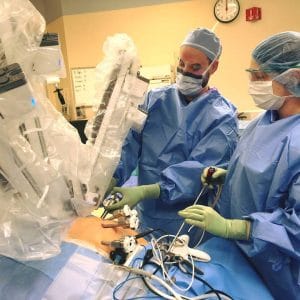Colon Surgery
What is a colectomy?
A colectomy is an operation to remove a part of the intestine that is diseased. The name of the procedure depends on what section of the intestine is removed.
The colon is shaped like a large upside-down U.
- Right hemicolectomy is the removal of the ascending (right) colon
- Left hemicolectomy is the removal of the descending (left) colon
- Sigmoidectomy is the removal of the lower part of the colon, connected to the rectum, on the left side of the abdomen
- Low anterior resection is the removal of the upper part of the rectum
- Segmental resection is the removal of only a short piece of the colon
- Abdominal perineal resection is the removal of the sigmoid colon, rectum and anus, and the construction of a permanent colostomy
- Total colectomy is when the entire colon is removed and the small intestine is connected to the abdominal wall as an ostomy, or connected to the rectum
- Total proctocolectomy is the removal of the rectum and all or part of the colon
A colectomy can be performed by an open technique, with a large incision, or in a minimally invasive fashion, with small incisions and a camera, with or without robotic assistance. The type of operation your surgeon will recommend will depend on the reason you are having a colectomy, the size of the diseased area or tumor, and the location of the diseased area or tumor. Your health, age, anesthesia risk, and surgeon’s expertise are also important.
 Minimally-invasive colectomy:
Minimally-invasive colectomy:
The colectomy can be done with long tools and a lighted camera or with a robotic assistance. Instead of a large incision, several small incisions are made in the abdomen, and ports or hollow tubes are inserted into those openings. Surgical tools and a lighted camera are placed through the ports. The abdomen is then inflated with carbon dioxide, which allows the surgeon to see the intestines and organs clearly. Small instruments and robotic tools are inserted into those ports are used to remove the diseased portion of the colon.
Benefits of a minimally-invasive colectomy include less scarring, earlier return of colon function, shorter hospital stay, less chance of postoperative hernias, and less pain. There is no difference between minimally-invasive and open colectomy, for cancer surgery, as far as 5 year cancer survival rates.
Keep in mind that during the course of your minimally invasive colectomy, if there are complications or unexpected findings, your surgeon may need to convert to an open colectomy through a larger incision.
Open colectomy:
An incision is made in the abdomen and the diseased section of the colon are removed. The remaining portion of the colon are then stitched or stapled back together. If the colon cannot be put back together, it is brought up through an opening on the abdominal wall to form an ostomy. Waste will empty through the ostomy into a pouch that is fixed around the ostomy on the abdomen.
Open colectomy may be the best option depending on your history of prior complex abdominal surgeries, or the size or amount of colon that needs to be removed. Whenever minimally invasive surgery is an option, we prefer to employ that technique given its benefits.
Possible complications of colectomy:
- Wound infection
- Anastomotic leak (a leak from the connection that is made between the two ends of the intestine that was sewn together)
- Bleeding
- Injury to other organs
After surgery, contact your surgeon if you have:
- Pain that will not go away
- Pain that is getting worse
- A fever more than 101 degrees F
- Continuous vomiting
- Swelling, redness, bleeding, or foul smelling drainage from your incision site
- Strong or continuous abdominal swelling or pain
- No bowel movement by 2-3 days after the operation
References:
American college of surgeons